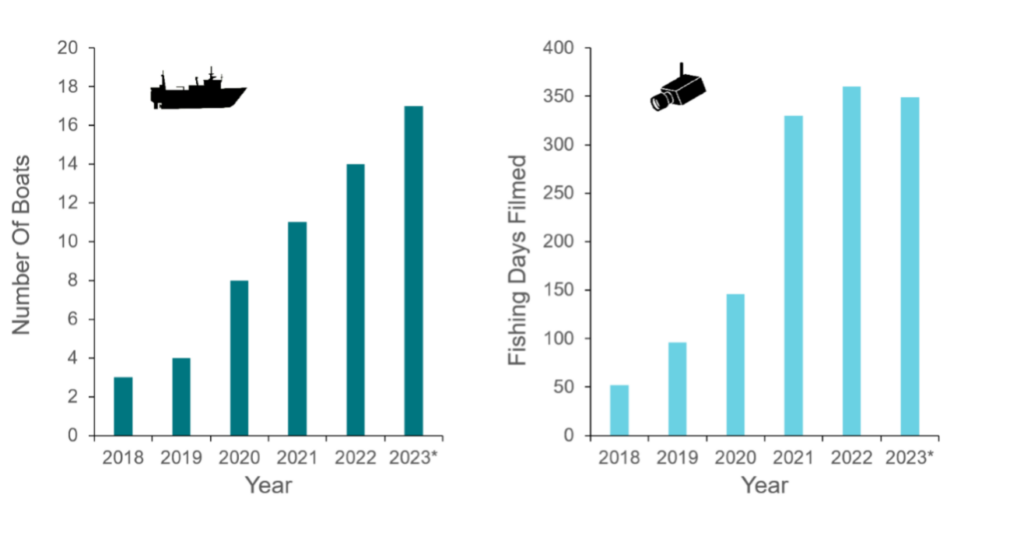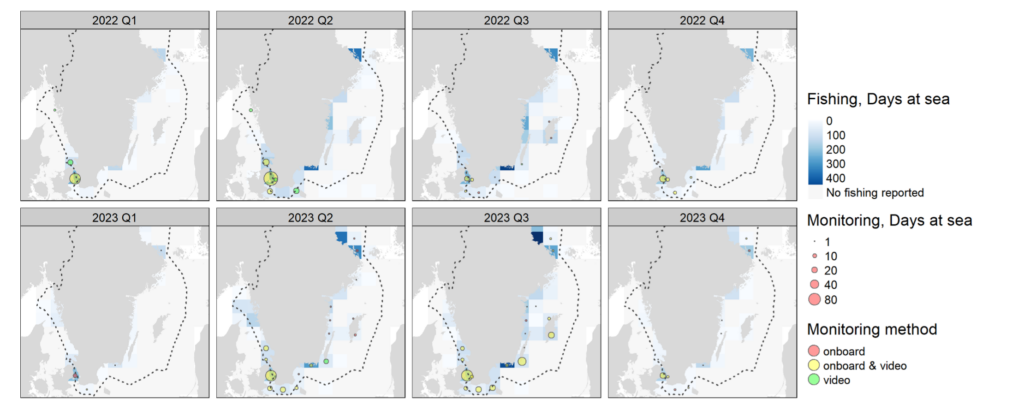At the Swedish University of Agricultural Science’s Department of Aquatic Resources (SLU Aqua), we are collaborating with commercial fishers on electronic monitoring projects to study bycatch of marine mammals, seabirds and elasmobranches. Of particular interest is our work relating to bycatch of critically endangered Baltic harbour porpoises in the small-scale gillnet fleet in southern Sweden. The reason for the focus on the Baltic harbour porpoise? The population is estimated to be down to less than 500, with the impacts of fishing and pollution playing a large role in the collapse since the mid-20th century. There is a real concern that the population faces extinction and an urgent need to better assess, understand and minimize bycatch levels. The roll out of electronic monitoring in Sweden was given real impetus over the last few years when the EU instigated an infringement process against Sweden (i.e. starting fining) for failure to meet its obligations and effectively monitor harbour porpoise bycatch in its waters (both in the Baltic sea and off the Swedish south west coasts). In this article, we give a brief overview of Swedish electronic monitoring.https://edition.mv/news/35539
EM Trial Stages
 Electronic monitoring was trialed in Sweden as early as 2008 and has been used in various trials and research since then (For example, research assessing the impact of acoustic pingers on bycatch reduction). In 2018, SLU began an expansion of trials of EM systems as a potential means of assessing bycatch in Swedish small-scale fleets and meeting its EU obligations. The focus was assessing bycatch of protected endangered and threatened species rather than monitoring targeted catch or using EM for compliance and control purposes. The commercial fishers with EM systems onboard were voluntarily involved and participation increased steadily (Figure 1) with the main impediment to further uptake being too few EM systems on hand and commercial fishers having to wait to join the program.
Electronic monitoring was trialed in Sweden as early as 2008 and has been used in various trials and research since then (For example, research assessing the impact of acoustic pingers on bycatch reduction). In 2018, SLU began an expansion of trials of EM systems as a potential means of assessing bycatch in Swedish small-scale fleets and meeting its EU obligations. The focus was assessing bycatch of protected endangered and threatened species rather than monitoring targeted catch or using EM for compliance and control purposes. The commercial fishers with EM systems onboard were voluntarily involved and participation increased steadily (Figure 1) with the main impediment to further uptake being too few EM systems on hand and commercial fishers having to wait to join the program.

Monitoring program
In July 2020, the EU initiated an infringement procedure against Sweden for non-compliance with the habitats directive related to monitoring porpoise bycatch, which led to an urgent need for Sweden to fast track the expansion of EM beyond our trials and research-only projects and implement wider monitoring (both by observers and by EM). As a result in 2022, mobile EM systems became the one of the key monitoring methods within the EU Data Collection Framework (DCF) for tracking protected species bycatch in Swedish small-scale gillnet fisheries. By the end of 2023 seventeen gillnet vessels on the Swedish west and east coast were equipped with monitoring systems, and many of the 120 remaining vessels in the fleet expected to follow suit over the coming years
EM has proven to be a good method of detecting porpoise bycatch (Figure 2), with results comparable to onboard observation and logbook data generally, and potentially more reliable for recording bycatch dropping out of the net before it comes over the side onto the deck. Most of the EM ‘effort’ to date has been in the southern half of Sweden (Figure 3), which corresponds with the known range of the harbour porpoise in Swedish waters.


The EM systems in use
Key requirements identified for EM systems for Swedish small-scale fisheries, were that they had to be, among other things, mobile, allow high frame rates and have good resolution options. Trials using various systems led to a list of requirements not met by systems available on the market at the time, and as a result, a number of systems were developed in-house to meet those needs. One of those systems, the HafsAuga MobileEM (Figure 4), is a cost-effective, mobile, multi-camera system that records high-quality video at up to 60 fps. It is lightweight (~2kg), easy to deploy (<30 minutes), and adaptable. It can connect to a vessel’s power source or run on an internal battery, recording continuously for over a week on one charge if needed. Deployable in under 30 minutes, the HafsAuga system is ideal for use on small vessels and where random fleet sampling is required. Our other mobile system, the LP-SCAM, designed specifically with remote offloading and strict data security in mind, is also being rolled out onto more vessels. Both of these systems’ output is compatible with Blackbox analyzer from Anchorlabs Denmark.

Other SLU Aqua research projects using EM
Various other SLU research projects are underway using EM to assist with compiling research data e.g. assessing pinger effectiveness. And like many programs nowadays, the search for a way to speed up analysis of EM data has led to us to machine learning. We have successfully developed algorithms for detection of bycatch (porpoise, seals, seabirds primarily) with good results (Basheer and Abdullah 2022, Svensson et al. 2023) and are now in the process of integrating this with an in house GUI to allow us to semi-automate the detection of bycatch events.
What’s next in Swedish EM?
So far, most of the outcomes from the introduction of EM in Sweden have been positive and the rollout of EM in Swedish small-scale fisheries, to monitor bycatch in particular, is almost certainly going to continue and likely at an increasing pace. Whether EM take-up occurs in larger vessels in Sweden is a question that remains unanswered. At present, there does not seem to be much of a push for that to happen. Taking machine-learning algorithms that have already been developed here and better integrating them into ‘day to day’ analysis on the ground may be the key to getting EM uptake beyond the small-scale fishery. In any case, EM has its foot in the door here and the next few years could really see EM in Sweden take off.
Dr. Lachlan Fetterplace is an Environmental Assessment Specialist at the Swedish University of Agricultural Sciences (SLU AQUA). He has extensive experience in camera-based research and aquatic monitoring in Australia and Scandinavia.
Basheer, F. and M. Abdullah (2022). Detection and classification of protected species bycatch in Swedish small-scale fisheries, Chalmers University, Sweden.
Svensson, E., L. Fetterplace, K. Ringdahl and S. Königson (2023). Towards automated bycatch detection in Electronic Monitoring data: a case study on small-scale fisheries and porpoises bycatch in gillnets. Conference: ICES Annual Science Conference. Bilbao, Spain.


